
 |

|
|
|
|
Height: 6' 2" (1,88 m) Weight: 175 lbs (79 kg) Eyes: blue/ brown * Hair: black curly Marriages: (1) June Jeannette White **, actress (Jul 28. 1930 - annulled 2 weeks later; Oct 12. 1930 - Jan 1935, divorced) (2) Sylvia Lowenthal (Sep 27. 1936 - Dec 1936, divorced) (3) Norma Finkelstein, animator (Jul 15. 1937 - Jan 8. 1986, her death) Children: David Anthony "Tony" Roberts, actor (Oct 22. 1939 - Feb 7. 2025) Nancy Roberts, actor (1946 -) (4) Sydell Salzberg (Jul 13. 1997 - Jun 19. 2009, his death) Siblings: Shirley Trachman (sic) (1913 - ) |
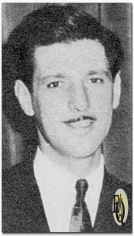 |
| Above right: Announcer Ken Roberts | |
|
Ken(neth) Roberts was born as Saul Trochman on February
22. 1910, in Manhattan, and grew up in The Bronx. His father, Nathaniel, an
insurance salesman and English tutor from Latvia, and his mother, Fanny Anna Naft,
from present-day Ukraine, were both Jewish immigrants to the United States. In November 1927, an effort was made by the Educational Alliance to reinstate the type of work originally attempted by the Neighborhood Playhouse at modest prices (50 cents). They offered Captain Applejack for their debut. Directed by Myron E. Sattler, the cast included Edna V. Fleischman, Helen Jelly, Clarice Saymon, Ruth Russell, Henry Chuck, Saul Trochman, William Green, Joseph D. Kane, Sigmund Kay, and Lester Shatzman. In December 1927, The Alliance Players—Sigmund Kay, Saul Trochman, Lester Shatzman, and Edna V. Fleischman—prepared for the revival of Within the Law. The Association Players' Stock Company of the Y.M.H.A. New York brought The Dance Below with Pat Fell, Saul Trochman, and Eve Lynn, again under the direction of Myron E. Sattler (The Manhattan Little Theatre Club, May 1928). He was with the Association Players when they won the Belasco Tournament. He left law school in 1928, according to family lore, because he couldn't afford the bus fare and the firm wouldn't give it to him. He wasn't interested in law, anyway and wanted to be an actor. He put on plays for the underprivileged kids as Eddie Cantor's camp at Surprise Lake, N.Y. He left school and initially took a job as a bookkeeper in Wall Street, and began saving a dollar a week in a Wall Street bank. After 3 weeks he was fired and decided to withdraw his entire savings - two bucks. The teller studied the withdrawal slip, checked Roberts' records and excused himself to another room. A few minutes later he returned and ushered the now uneasy Roberts into the plush office of the veepee. The bank official and the teller double-checked the bank statements and the $2 withdrawal notice. Then, suddenly, the exec look up and asked, quizzically. "What's the matter, Mr. Roberts? Don't you like our bank?" He then joined Christopher Morley's stock company in Hoboken which carried its beer-and-pretzel revivals of 19th Century favorites. Ken ended up playing leads there after nine months. He appeared in After Dark (as the villain), The Black Crook and The Cradle of the Deep. He performed under the his own name with the Association Players/The Manhattan Little Theatre Club under production of Walter Hartwig (between 1928 and 1930) with The Man in the Stalls (for a Little Theatre Tournament at the Waldorf Theatre, May 7. 1929) and Seven Against One (Waldorf Theatre, May 6. 1930), both directed by Myron E. Sattler. In this first play, he starred alongside Pat Fell, Eve Lynn, and June White (his first wife). Dramatic work over WPCH was his first taste of radio followed by a short term as radio announcer at WMCA. He changed his name after entering the radio business so that it would not "sound so Jewish" into Kenneth Truman! The man who hired him at WMCA was the chief announcer A.L. Alexander asked him to change his name thinking people wouldn't understand "Truman" over the microphone "it's to explosive". "Clyde Roberts" was the suggested alternative but they settled on "Kenneth Roberts". He left WMCA after a couple of months to fill a previous contract playing summer stock with the Cedar Hills company at Lakeville, Conn. At the end of the summer he was determined to be an announcer rather than an actor. A friend on a Brooklyn newspaper introduced Ken to the manager of a Brooklyn station WLTH "The Voice of Brooklyn" at a propitious moment. The station's announcer was preparing to leave that day and the applicant, after a test, was hired on the spot. In addition to announcing, he played piano and read poetry on the air, answered the telephone and swept the floor. And apparently he wanted to get out from under his parents' roof; he wed twice before he was 26. The first marriage, which lasted two weeks, was annulled; the second ended in divorce after a few months. "We jokingly said he did it to get out of the house," Tony Roberts said in an interview. "In those days you needed a reason." After six months the work at WLTH and the long subway ride got too tiring so he applied for a WABC audition, and in February 1931, he was chose from 30-40 candidates as a Columbia announcer. He stayed with WABC for twenty years. In his first years at the Columbia Broadcasting Service he did everything from describing crew races to welcoming the King of Siam. He was prominently heard in dramatic presentations offered by the studio, such as the March of Time programs or The Fred Allen Show (CBS 1932 - 1933). |
|
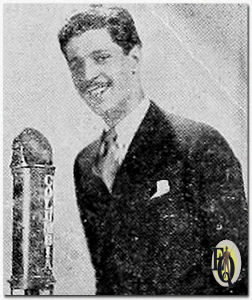 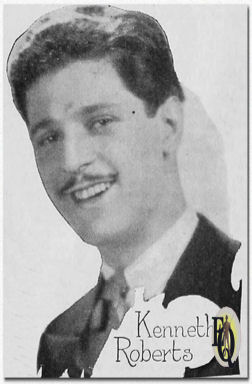 Above left: Kenneth Roberts, new CBS announcer, is heard locally through station WKRC on network programs. He left the stage in favor of radio broadcasting (Weekly Radio Dial, May 28. 1931) Above right: same photo in detail |
|
|
It was reported (1933) he also had singing as hobby and
after having studied both piano and voice was continuing his musical
studies. Spare time, if any was devoted to horseback riding, swimming,
tennis and bridge. Roberts also had a marked aptitude for clay modeling. In the 1930s and ’40s, the heyday of radio, this was the lot of the announcer, the man who introduced serials and other narrative shows always live on the air and read advertisements and moderated game show panels. And like few others, Mr. Roberts was ubiquitous, the voice of dozens of shows, a star without a name or a face, often announcing on six radio programs a day. In a 1935 article in Radio Mirror on the earnings of announcers it was reported Kenneth Roberts earned between $85 and $125 weekly depending on the breaks. The average was about $40 a week. |
|
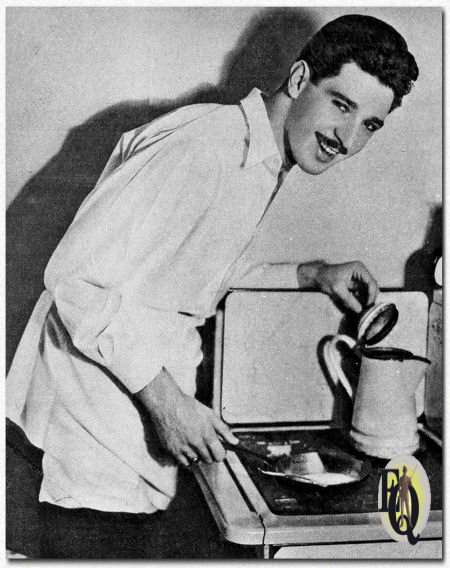 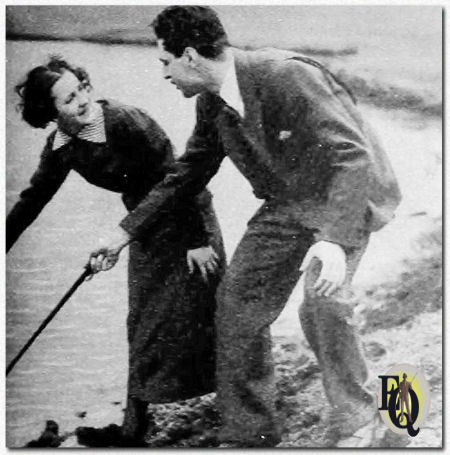 Above left: An announcer turns culinary as Kenneth Roberts gets his own breakfast, and what's more, eats it, too! (Radio Mirror, 1934) Above right: Connie Gates and Kenneth Roberts (Radio Stars, Aug 1935) |
|
|
Roberts was also a labor leader. In 1935 he founded the American Guild of Radio Announcers and Producers, which eventually became part of the American Federation of Radio Artists, a forerunner of the American Federation of Radio and Television Artists, known as AFTRA.
The Hour of Charm (CBS, 1935 - 1948), Despite dashing good looks and an incredible voice, Ken Roberts had only one major acting role to his credit, as dimwitted athlete Mel Kahn in Hitch Your Wagon (48th Street Theatre, Apr 8. - May 1. 1937).
A subsequent marriage in 1937 lasted nearly 50 years,
until the death of his third wife, Norma Finkelstein. When The Adventures of Ellery Queen first started on radio on June 18. 1939 Ken Roberts was the announcer. He stayed on until April 21. 1940 when he was replaced by Bert Parks. |
|
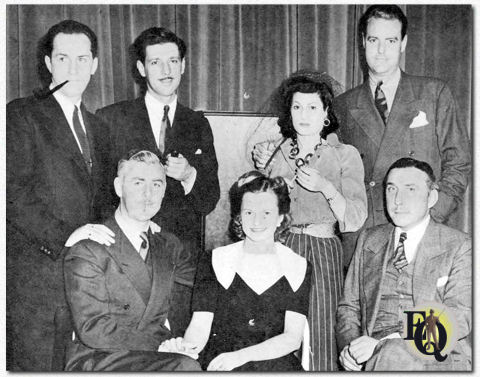 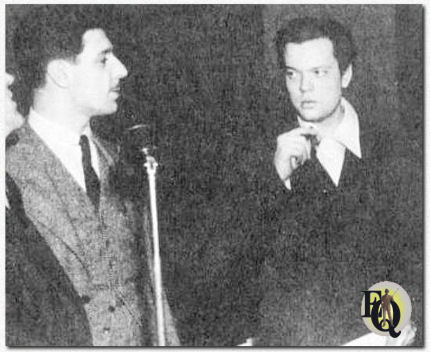 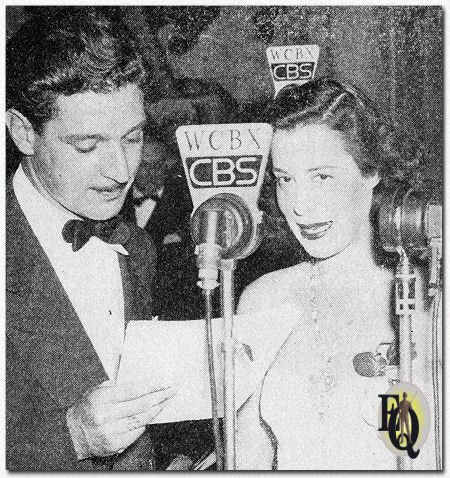 Top: The cast of The Shadow, seated (L-R): The Shadow (played by Bill Johnstone), Margot Lane (Marjorie Anderson), Weston (Artur Vinton). Standing (L-R): Shrevie (Keenan Wynn), announcer Ken Roberts, organist Elsie Thompson, director Wilson Tuttle (Movie Radio Guide, Dec 14. 1940) Above left: Behind the scenes at an early Shadow broadcast (L-R) Carl Frank, Ken Roberts and Orson Welles (1937). Above right: Kenneth Roberts announces Kittly Carlisle at a party where her songs were one of the party's biggest hits. (Cinelandia, 1941) |
|

| Jack Johnstone, director of Crime Doctor on CBS, topped all the proverbial gags about cue-tossers on the broadcast November 15. 1943. Giving a music cue to conductor Ray loch, he/accidentally hit announcer Ken Roberts in the face, breaking his nose. Johnstone is one of the few directors who work in the studio with the actors, instead, of from the control booth. When the mishap occurred, Roberts was standing a couple of feet from Johnstone's side, waiting to step to the microphone to read the middle commercial. The force of the blow stunned him, but he quickly held a handkerchief to his nose to stem the spurt of blood, and managed to get through the commercial without interruption: The gasp and subsequent buzz of conversation from the studio audience was audible over the air. | |
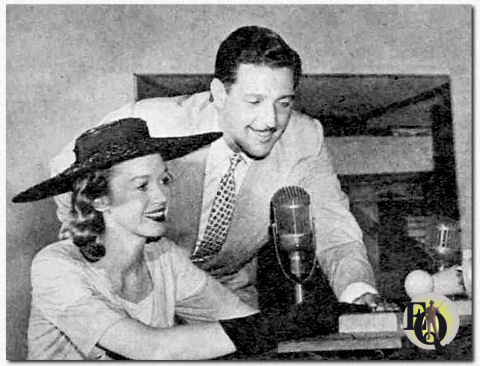 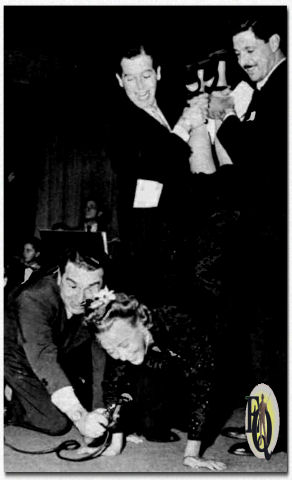 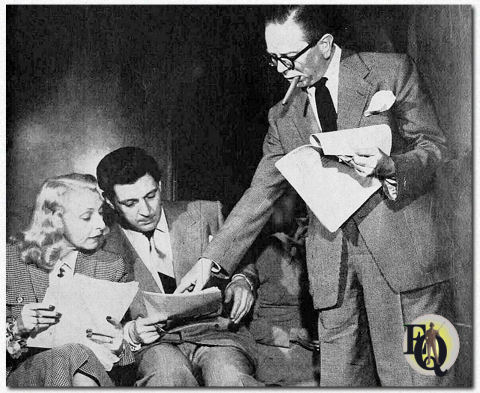 Top left: Quick as a Flash EMCEE KEN ROBERTS shows fair contestant how to work the buzzer and tells her rules of broadcast. Every one of the six guests has an equal chance at the questions, may participate as often as he wishes. (Radio Life, Jan 1945) Top right: Let Yourself Go that zany, exhibitionistic program which couldn't fit comedian -emcee Milton Berle more perfectly if it were tailored for him. DIVA GRACE MOORE gets in the spirit by singing upside-down, aided by scripter Hal Block, supported by Milton Berle and announcer Ken Roberts. Above: Goodman Ace, writer-producer director and co-star of CBS' mr.ace & JANE, points up a laugh-line for his wife Jane and announcer Ken Roberts during rehearsal of the bright new Saturday comedy series. Roberts also doubles in the script as the ebullient radio announcer who lives next door to the Aces. (Mar 1948). |
|
|
He was the host and announcer for the game show Quick as a Flash
(Mutual, 1944 -1949),
in which historical events or current events were dramatized, and
contestants were asked to identify them. Ken owned the program which was a
huge step in his career. Win Elliot replaced Ken Roberts as emcee in 1947.
The show was dropped from the Mutual lineup in 1949, but returned that fall
as an ABC daytime show, three times a week for Quaker Oats. Bill Cullen
served as host in this last version. In 1950 - 1951, its last season, Quick As a
Flash was heard each morning for Block Drugs. The Philip Morris Follies of 1946 (NBC, 1946), This is Nora Drake (CBS ,1947 - 1951) In 1948 he was heard in the popular serial Easy Aces (CBS, 1948). In the 1950s Ken Roberts made the transition to television, appearing on game shows, serving as the original announcer for Candid Camera and lending his voice to a popular program starring Jan Murray, Dollar a Second, for which he also did on-air commercials for the show’s sponsor, Mogen David wine. He was also the emcee for the television shows at DuMont: Ladies Before Gentlemen, a panel show where male celebrities interviewed a female guest who defended the feminine point of view on the topics discussed (DuMont, 10 episodes starting Feb 21. 1951); Where Was I? (DuMont, 1952 - 1953); and Insider Detective (DuMont, 1952, min. 4 episodes). But his most enduring television legacy was as the announcer for two long-running daytime soap operas, Love of Life (CBS, 1951 - 1971) and The Secret Storm (CBS, 1954 - 1974). |
|
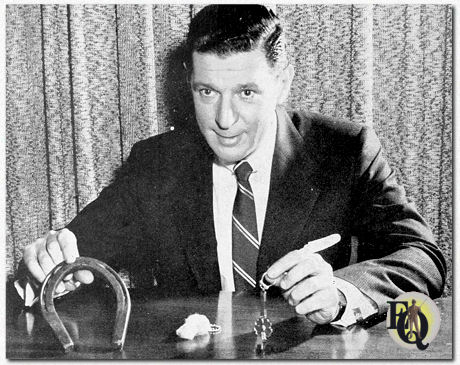 Above: Host Ken Roberts delivers live, gimmicky Sealy Mattress commercials for clever contrast with steady diet of film offered by the New York- New Jersey mattress company (Sponsor, Mar 5. 1956). |
|
|
He announced on The Electric Company
(CTW/PBS, Oct 25. 1970 - Mar 10. 1972, 130 episodes). As perhaps one of the most identifiable voices in radio, Woody Allen utilized Ken Roberts as the announcer in his movie Radio Days (Orion, 1987) ***. He did some additional voices on the animated series Action Man (ABC, 1995 - 1997, 26 episodes). |
|
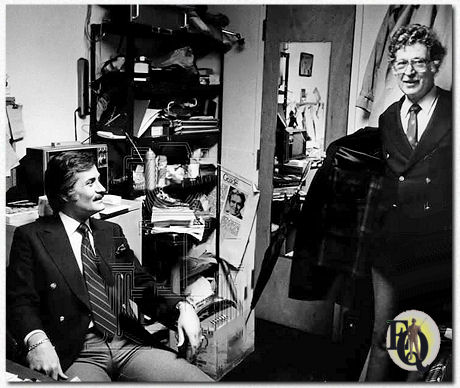 Above: John Aniston (left), featured regularly as wealthy Martin Tourneur on the daytime drama Search for Tomorrow, who is also a restaurant-cabaret co-owner, discusses business with a stockholder, Ken Roberts, a longtime CBS announcer, at "The Fives," located across from the CBS Broadcast Center on New York City's West Side. The serial, television's longest-running daytime drama, is presented weekdays, 12:30-1:00 PM, ET, on the CBS Television Network. (CBS, May 30. 1980). |
|
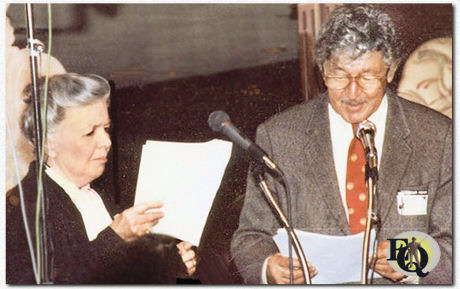 Above: Margot Stevenson (Margot Lane) and Ken Roberts ( Shadow announcer) recreate a classic Shadow radio program. |
|
|
He died of pneumonia on June 19. 2009 at New York Presbyterian Hospital in Manhattan at 99, having had a stroke five years earlier. He was survived by his wife, Sydell; a daughter, Nancy Roberts, of Fire Island, NY; a granddaughter, two stepchildren and four step-grandchildren. "I saw him as one of the leading lights of radio," said Jim Cox, the author of several books on radio history. "What was remarkable about Mr. Roberts's voice", Mr. Cox said, "was that it was without any regional accent and yet distinctive, authoritative yet reassuring." |
|
|
"It didn't sound Yankee, Southern, Western or anything else," Mr. Cox said. "There was nothing in it to irritate anybody. It was one of those voices you just naturally liked to hear."
"My father's voice did sound to me as though it came
from God," Tony Roberts said. "He had no accent; he spoke in
perfect tones and complete sentences." |
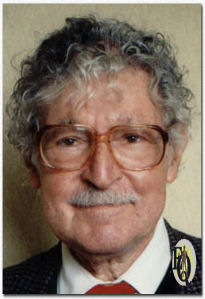 |
|
Notes: * According to the article "Notes on the Mr.Roberts of Radio" (The New York Times, Sep 23. 1945) his eyes were blue. A 1934 short bio in Radio Stars "Who's Who behind the Mike", stated Kenneth Roberts had brown eyes. ** June (Jeannette) White was an actress who played on Broadway. She's seen in plays between 1914 and 1935. Not to be confused with another actress June White (1922 - 2011). An article in Radio Mirror (Jan 1935) announced the divorce of June and Ken, June reportedly preparing to get married to actor John Brown. *** His acting performances are often mixed up with those of a Texas born actor who is also named Ken Roberts All dates for movies are for the first US release. All dates for TV programs are original first airdates. All dates for (radio) plays are for the time span the actor was involved. Programs, facts or dates in red still need confirmation. |
|
|
Click on Uncle Sam if you think you can help out...!
|
|
|
Other references
Additional video & audio
sources |
|
|
This profile is a part of
Ellery Queen a website on deduction.
The person above was announcer for the
Ellery Queen
radio
series.
Click Uncle Sam if you think you can help
out...! Many of the profiles on this site have been compiled after very careful research of various sources. Please quote and cite ethically! |
|
|
Page first published February 8. 2025 Version 1.1 - Last updated April 25. 2025 |
|
 b
a c k
t o L i s t o f S u s p
e c t s
b
a c k
t o L i s t o f S u s p
e c t s
|
|
| Introduction | Floor Plan | Q.B.I. |
List of Suspects | Whodunit? | Q.E.D. | Kill as directed | New | Copyright Copyright © MCMXCIX-MMXXV Ellery Queen, a website on deduction. All rights reserved. |